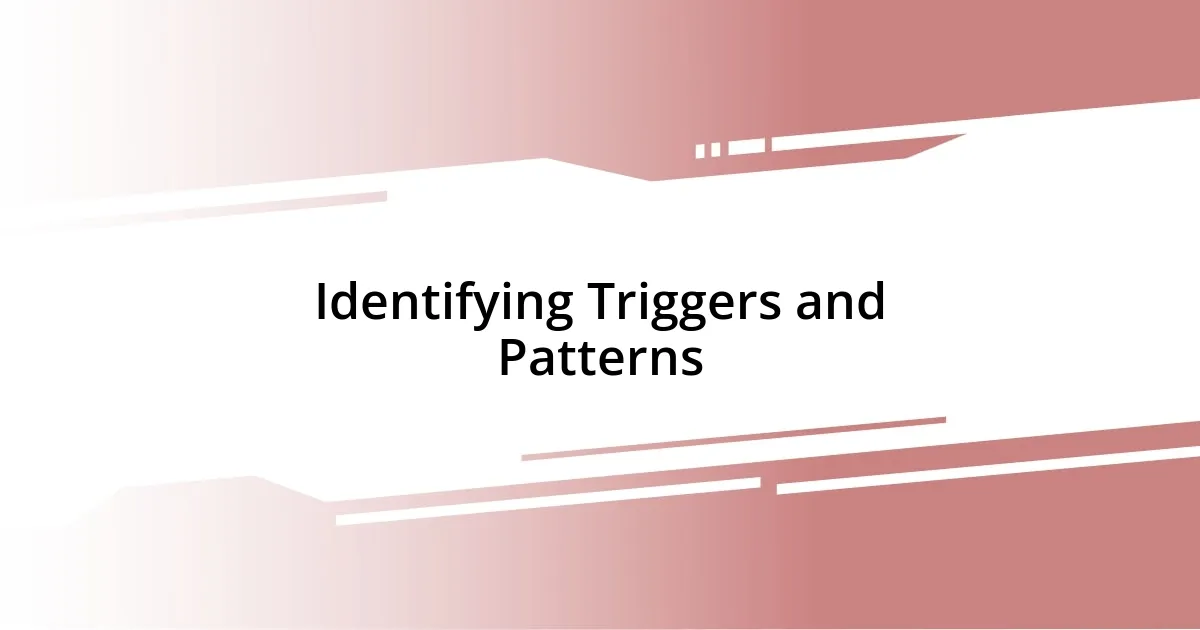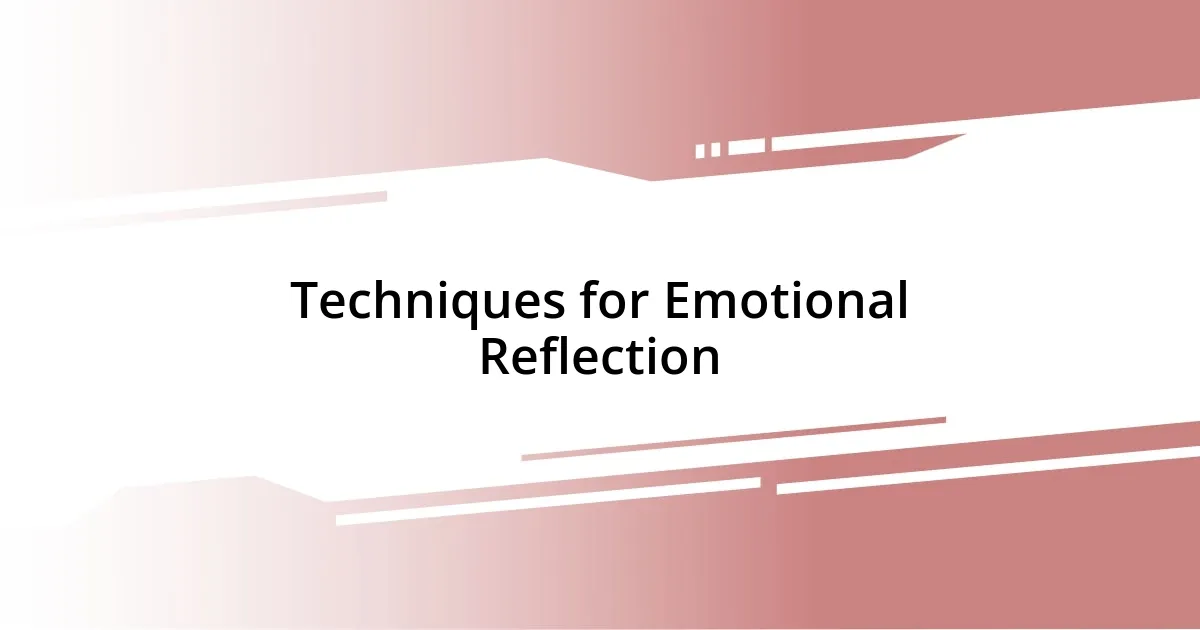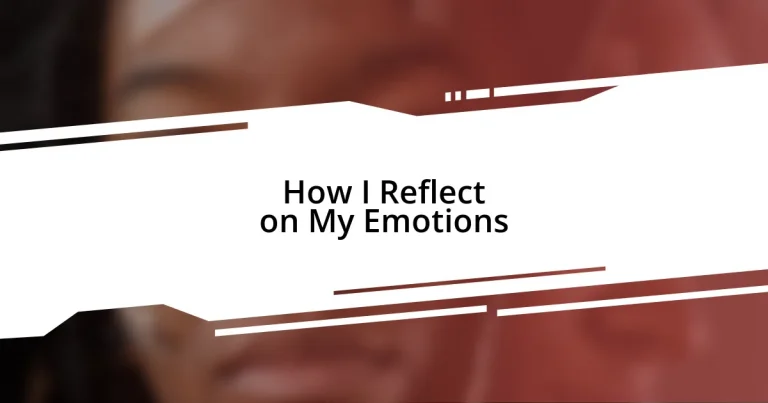Key takeaways:
- Understanding emotions involves recognizing triggers and patterns, which can lead to deeper self-awareness and processing of feelings.
- Journaling is an effective tool for emotional reflection, providing clarity and helping to transform abstract feelings into tangible insights.
- Mindfulness enhances emotional awareness by creating space between stimuli and reactions, promoting self-compassion and understanding.
- Seeking professional guidance can illuminate overlooked aspects of emotions and introduce accountability in one’s emotional journey.

Understanding My Emotional Landscape
When I think about my emotional landscape, I realize it’s a vast terrain filled with peaks and valleys. For instance, there are days when a small comment can trigger waves of sadness, making me reflect on past experiences that still resonate. Have you ever felt something similar, where an unexpected feeling catches you off guard?
Understanding my emotions requires me to pause and really listen to what they’re telling me. Recently, I had a moment when nostalgia hit hard while flipping through old photographs. This simple act pulled me into a whirlwind of longing for moments gone by; it made me wonder: why do certain memories evoke such strong feelings, while others fade away?
I’ve learned that feelings don’t just come and go; they often hold valuable insights about my inner self and my values. For instance, when I feel anger surfacing, it often leads me to examine boundaries that may have been crossed. I ask myself, what is this anger trying to protect? In those moments of reflection, I uncover deeper reasons behind my feelings, adding clarity to my emotional landscape.

Identifying Triggers and Patterns
Recognizing the specific triggers that ignite my emotions is a game changer. I remember a particularly tense moment in a team meeting when a colleague dismissed my ideas. The sting of rejection made me feel unappreciated, but I realized it wasn’t just about that moment. It unearthed a pattern of insecurity I carry about my contributions, leading me to ask: what is it about this situation that hits so hard?
To effectively identify these triggers and discern emotional patterns, I often reflect on the following:
- Contextual Influences: Certain environments or situations amplify my feelings, like feeling overwhelmed in crowded spaces.
- Physical Responses: I notice changes in my body, such as a racing heart or clenched jaw, signaling heightened emotions.
- Recurrent Themes: Common threads emerge, like feeling triggered by criticism, revealing underlying fears of inadequacy.
- Time of Day: I’ve found that my emotions tend to be more intense in the early mornings, possibly due to fatigue or anticipation of the day ahead.
- Previous Experiences: Old memories often color my reactions, leading me to reflect on how unresolved issues influence my present.
Understanding these aspects helps me navigate my emotions more authentically. Each insight adds another layer to my emotional discernment, guiding me through my personal landscape.

Techniques for Emotional Reflection
One of the techniques I find effective for emotional reflection is journaling. When I set aside time to write, I can unpack my feelings in a safe space, allowing my thoughts to flow freely. I remember a time when I was feeling particularly anxious about a big presentation. Writing about my fears helped me see them in black and white, transforming abstract worries into manageable emotions. Have you ever tried journaling? It might surprise you how much clarity it can bring.
Another approach I use is mindfulness meditation. I carve out moments throughout my day to focus on my breath, observing my thoughts without judgment. It’s like taking a step back and watching clouds drift by. The ability to sit with discomfort has taught me that emotions are temporary and often rooted in something deeper. It reminds me of a day when anger bubbled up unexpectedly; by simply breathing and acknowledging that anger, I discovered it stemmed from feeling unheard in a conversation.
Lastly, talking it out with a trusted friend or therapist can provide invaluable insight. When I share what’s on my mind, their feedback often sheds light on perspectives I hadn’t considered. I recall discussing a heavy decision with a close friend; his questioning helped me explore underlying fears I had yet to confront. Engaging in dialogue allows the emotions to breathe, and I’m often left with a sense of connection and understanding.
| Technique | Description |
|---|---|
| Journaling | Writing about emotions to gain clarity and insight, transforming abstract feelings into tangible understandings. |
| Mindfulness Meditation | Focusing on breathing to stay present with feelings and recognize their transient nature. |
| Speaking with Friends or Therapists | Discussing feelings with others to gain external perspectives and uncover deeper emotional truths. |

Journaling as a Reflection Tool
Journaling has become a cornerstone of my emotional reflection process. There’s something cathartic about putting pen to paper; it’s almost as if I’m having a conversation with myself. I vividly remember a time when I was feeling overwhelmed with my responsibilities. Writing down everything I had on my plate helped me realize that it wasn’t as daunting as it seemed. Suddenly, I could prioritize tasks instead of feeling crushed under their weight. Have you ever experienced that? It’s remarkable how externalizing thoughts can bring such clarity.
Sometimes, I feel like my emotions are tangled up in a web until I start writing. When I reflect on a particularly challenging week filled with frustration, I often find solace in my journal. For instance, after a disagreement with a family member, I poured my feelings onto the pages. What surprised me was how my initial anger transformed into understanding as I articulated my thoughts. Could it be that writing helps us process emotions more deeply, allowing us to discover intentions we weren’t aware of? I genuinely believe it can.
Moreover, journaling serves as a perfect time capsule for my emotional growth. When I revisit past entries, I see how I’ve evolved. One entry from a year ago had my heart racing – I wrote about feeling utterly lost in my career. Yet, looking at it now, I can see how those feelings were a catalyst for change. It’s a powerful reminder that our emotions, while intense, can lead us down paths of growth and self-discovery. Wouldn’t you agree that reflecting through journaling is not just about venting but also about transforming and evolving?

Mindfulness and Emotional Awareness
Mindfulness plays a crucial role in developing emotional awareness. When I practice mindfulness, I often notice the subtle shifts in my feelings, like the weight of sadness or the lightness of joy. For instance, during a recent hike, I paused to breathe deeply and simply observe the beauty around me. In that moment, I felt a wave of gratitude wash over me, highlighting how tuning in to my surroundings allowed me to connect with my emotions more profoundly. Have you ever experienced such a moment where being present unlocked a deeper understanding of what you’re feeling?
What I’ve found particularly interesting about mindfulness is its ability to create space between stimulus and reaction. There was a time when I felt overwhelmed by criticism at work. Instead of reacting impulsively, I took a few minutes to breathe and acknowledge my feelings. This practice helped me realize that the criticism was an opportunity for growth rather than a personal attack. By recognizing my emotions as mere signals rather than definitive truths, I gained clarity on the situation. Isn’t it incredible how this perspective shift can alter our response?
Additionally, being mindful has taught me the importance of self-compassion in emotional awareness. I recall a period when I struggled to embrace challenges without harsh judgment. Practicing mindfulness, I learned to treat myself with the same kindness I would offer a friend. Instead of berating myself for mistakes, I now approach my feelings with curiosity and understanding. This compassionate lens has transformed my emotional landscape, making it easier to navigate life’s ups and downs. How do you nurture kindness towards yourself in your emotional journey?

Seeking Professional Guidance
Seeking professional guidance can be a transformative step in understanding and processing my emotions. I remember the first time I decided to talk to a therapist; it felt like stepping into a new world. Initially, I was hesitant, thinking it meant I had failed to handle my feelings on my own. But as I sat down in that welcoming office, I quickly realized it was a safe space to unravel my thoughts without judgment. Have you ever considered how freeing it might be to share your emotional load with someone trained to help?
The conversations I’ve had with professionals have illuminated aspects of my emotional life that I had overlooked. I recall a particular session where we explored my response to stressful situations. The therapist introduced the concept of cognitive distortions—these faulty ways of thinking that can amplify my negative feelings. As I learned to identify and challenge these patterns, I noticed a lightness in my heart, almost like lifting a heavy fog. Isn’t it fascinating how someone else’s perspective can help us see ourselves more clearly?
Moreover, seeking guidance often brings an element of accountability to my emotional journey. One time, my therapist suggested we track my emotions through a daily check-in. This simple practice held me accountable for my feelings and made me reflect more deeply each day. As I began to notice trends in my emotional responses, I felt empowered to make changes in my life. So, have you thought about how professional insight could offer you tools to navigate your feelings more effectively? It’s something I wholeheartedly encourage—sometimes, we just need a little nudge in the right direction.

Developing an Emotional Action Plan
Developing an emotional action plan starts with identifying what triggers various feelings in my life. I remember a time when stress from deadlines began to affect my mood significantly. I took the time to jot down my common triggers—whether it was tight schedules or certain interactions at work—and realized that naming these patterns gave me a sense of control. When was the last time you reflected on what really stirs your emotions?
Once I had my triggers outlined, I moved onto mapping out specific responses for each situation. For instance, when I felt that familiar pang of anxiety before meetings, I incorporated deep breathing exercises beforehand. There was one meeting where my heart raced, but I paused to breathe deeply and remind myself of my preparation. That moment of intentionality provided clarity and helped me approach the situation calmly. Have you considered how simple strategies can turn your emotional responses around?
Lastly, I found that regularly assessing my emotional action plan keeps it relevant and effective. I set aside time each week to review my experiences and adjust my strategies accordingly. For example, during a particularly challenging week, I noticed my initial responses weren’t as effective, leading me to experiment with journaling my emotions. This reflective practice not only highlighted my growth but also refined my plan to meet my evolving needs. Isn’t it empowering to realize that your emotional journey is flexible and can be shaped over time?














